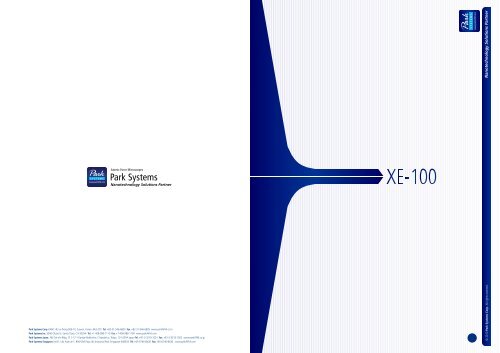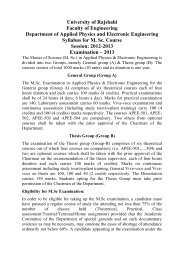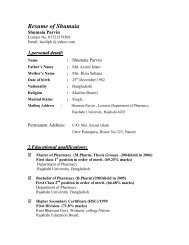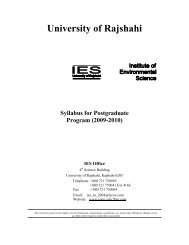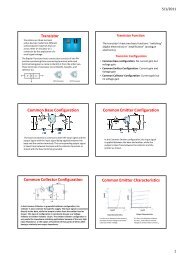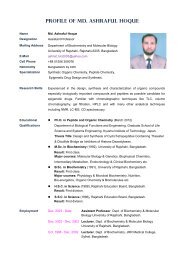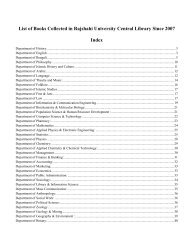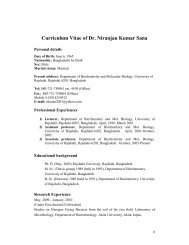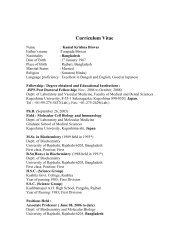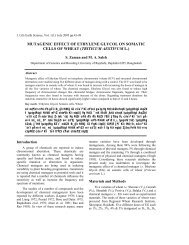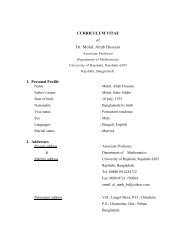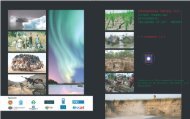(AFM), capable of doing Magnetic Force Microscopy
(AFM), capable of doing Magnetic Force Microscopy
(AFM), capable of doing Magnetic Force Microscopy
Create successful ePaper yourself
Turn your PDF publications into a flip-book with our unique Google optimized e-Paper software.
Nanotechnology Solutions Partner<br />
Park Systems Corp. KANC 4F, Iui-Dong 906-10, Suwon, Korea 443-270 Tel. +82-31-546-6800 Fax. +82-31-546-6805 www.park<strong>AFM</strong>.co.kr<br />
Park Systems Inc. 3040 Olcott St. Santa Clara, CA 95054 Tel. +1-408-986-1110 Fax. +1-408-986-1199 www.park<strong>AFM</strong>.com<br />
Park Systems Japan. NK Dai-ichi Bldg. 1F 1-17-1 Kanda-Nishikicho, Chiyoda-ku, Tokyo, 101-0054 Japan Tel. +81-3-3219-1001 Fax. +81-3-3219-1002 www.park<strong>AFM</strong>.co.jp<br />
Park Systems Singapore. No51, Ubi Avenue 1, #06-09A Paya Ubi Industrial Park Singapore 408933 Tel: +65-6746-8438 Fax: +65-6746-8436 www.park<strong>AFM</strong>.com<br />
© 2010 Park Systems Corp. All rights reserved.
© 2010 Park Systems Corp. All rights reserved.<br />
Decoupled XY & Z Scanners<br />
High Resolution Digital CCD Camera with Digital Zoom<br />
Direct on-axis high resolution digital CCD camera with digital zoom capability<br />
allows high clarity and high resolution image quality regardless <strong>of</strong> panning. This<br />
unique configuration enables the best quality and highest resolution (
Non-Contact <strong>AFM</strong><br />
Non-Contact <strong>AFM</strong><br />
Non-contact <strong>AFM</strong><br />
Pentacene<br />
TIO2<br />
A B C Zn/Al metalized polypropylene film<br />
D<br />
Scan size: 2.5 μm<br />
Scan size: 1000 nm<br />
Scan size: 12 μm<br />
Non-Contact <strong>AFM</strong><br />
NiS quantum dots<br />
Scan size: 500 nm<br />
© 2010 Park Systems Corp. All rights reserved.<br />
04 - XE-100<br />
A B<br />
C<br />
D<br />
Decoupled XY & Z Scanners<br />
XE-100<br />
XE-100<br />
05 -
20<br />
40<br />
60<br />
µm<br />
x 20.000 µm/d1<br />
z 50.000 µm/d1<br />
CROSSTALK ELIMINATION ( XE<br />
(<br />
XE ADVANTAGES<br />
The Problems and Limitations <strong>of</strong> Conventional <strong>AFM</strong><br />
Park Systems’ Commitment to Innovation<br />
A<br />
Z<br />
Y<br />
-X X<br />
-Y<br />
1. Scanner Bowing: Flat Scan is Not Possible!<br />
The conventional <strong>AFM</strong> uses a piezoelectric tube for the x-y-z scanner, where<br />
x-y motion relies on the bending <strong>of</strong> the tube. The bending motion, however,<br />
introduces background curvature and therefore causes z position errors.<br />
Conventional systems regularly use s<strong>of</strong>tware flattening to hide background<br />
curvature; this can be an impossible task since the amount <strong>of</strong> curvature<br />
depends not only on scan size and scan speed, but also on x-y <strong>of</strong>fset, z<br />
position, etc. Therefore, even after s<strong>of</strong>tware flattening, a flat surface does<br />
not always “look” flat as shown in the figure above.<br />
For over 25 years, Park Systems has developed a reputation as the <strong>AFM</strong> technology leader among major universities, renowned research<br />
institutes and industry leaders seeking nanometrology solutions through our:<br />
• Dedication towards <strong>AFM</strong> technology innovation<br />
• Proven strength to deliver successful solutions via partnership with clients<br />
Flat XY Scan: Precision Metrology Without Compromise<br />
Even after s<strong>of</strong>tware flattening, flat surface does not look flat.<br />
2. Slow Z-Servo Response: Non-Contact Mode is Not Possible!<br />
The award-winning XE-platform, completely eliminates<br />
background curvature and shows no bowing even on<br />
scans <strong>of</strong> the flattest samples, thus enabling precision<br />
nanometrology for even the most challenging problems in<br />
research and industry.<br />
Maximum peak-to-peak = 0.871 nm<br />
Repeatability = 0.481 nm<br />
The tube scanner is a slow actuator with highly limited Z-scan bandwidth <strong>of</strong> only 500 Hz or so. Therefore, the Z-servo response is slow and<br />
it is not possible to implement Non-Contact Mode, a critical requirement for preservation <strong>of</strong> sharp tips and non-destructive imaging <strong>of</strong><br />
s<strong>of</strong>t biological samples.<br />
The Fundamental Problems<br />
S<strong>of</strong>tware Correction Required (NOT Raw Data)<br />
Piezotube Scanner<br />
Max Y shifting<br />
Max X shifting<br />
• Background Curvature<br />
• Impossible to achieve a flat scan, even after s<strong>of</strong>tware correction<br />
0 degree 90 degree Image matching<br />
Highly Linear and Orthogonal XY Scan<br />
• Poor Linearity in XY Scan<br />
• Slow Z-servo Response<br />
• Small and flat features are distorted or wiped out<br />
• Impossible to realize non-contact <strong>AFM</strong><br />
XE-<strong>AFM</strong> XY-scanner<br />
The flexure XY scanner decouples the X and Y scan motion so that the coupling<br />
between X and Y movement is minimized. Position sensors provide linear<br />
feedback control for the high accuracy, high precision measurements.<br />
XE-Technology : Park Systems’ Answer to Conventional <strong>AFM</strong>’s Problems<br />
The problems and limitations <strong>of</strong> a conventional <strong>AFM</strong> calls for a completely new approach in the design <strong>of</strong> an <strong>AFM</strong>. Park Systems<br />
developed the Crosstalk Eliminated (XE) <strong>AFM</strong> which fundamentally and successfully resolves these problems.<br />
True Non-Contact-Mode is Now a Reality<br />
True Non-Contact Mode, one <strong>of</strong> the distinctive advantages<br />
which can only be realized by Park Systems’<br />
XE-<strong>AFM</strong>s, is a powerful method which enables <strong>AFM</strong> users<br />
to image and measure samples that other measurement<br />
or imaging techniques can not.<br />
True Non-Contact Mode<br />
• Small amplitude<br />
• Minimized tip-sample interaction<br />
• Less sample damage<br />
Tapping Imaging<br />
• Large amplitude<br />
• Destructive tip-sample interaction<br />
• Sample damage<br />
• Longer tip life<br />
• Short tip life<br />
Z-Scanner<br />
Flexure Guided High <strong>Force</strong> Z-Scanner<br />
In True Non-Contact mode, the tip-sample distance is successfully maintained at a few nanometers, hence improving the quality <strong>of</strong> <strong>AFM</strong><br />
images and preserving the sharpness <strong>of</strong> the tip. The sharp end <strong>of</strong> a tip is so brittle that once it touches a sample, it becomes instantly blunt<br />
and limits the resolution <strong>of</strong> an <strong>AFM</strong>. True Non-Contact mode maintains the tip sharpness, therefore improving productivity and clarity for your<br />
imaging needs.<br />
Tip Wearing Experiment with CrN Sample<br />
XY-Scanner<br />
Parallel Kinematic 2D Flexure Scanner<br />
Fig 1 and 2 illustrate a stark contrast in tip wearing between <strong>of</strong> True<br />
Non-Contact Mode and tapping imaging. The CrN sample used in the<br />
experiment is a typical <strong>AFM</strong> tip characterizer that has sharp and pointy features<br />
on a very hard surface.<br />
st<br />
1 scan<br />
th<br />
30 scan<br />
th<br />
70 scan<br />
th<br />
100 scan<br />
Mechanical Design Features Advantages<br />
Completely Decoupled XY and Z-Scanners XY-Scanner moves a sample only and Z-Scanner drives a probe Flat XY Scan without Bowing<br />
2D XY Flexure Scanner<br />
Minimal Runout<br />
Highly Linear and Orthogonal XY Scan<br />
Tapping Imaging<br />
st<br />
1 scan<br />
nd<br />
2 scan<br />
th<br />
5 scan<br />
th<br />
10 scan<br />
With True Non-Contact Mode, the sharpness <strong>of</strong> the tip is preserved even after<br />
100 scans.<br />
With tapping imaging, only after 10 scans, we see blurred images without<br />
sharp triangular features which are consequences <strong>of</strong> worn and damaged tips.<br />
High <strong>Force</strong> Z-Scanner<br />
Large Z Servo Bandwidth<br />
Enabling True Non-Contact Mode<br />
06 l 07 - XE-100 Decoupled XY & Z Scanners<br />
© 2010 Park Systems Corp. All rights reserved.
Decoupled XY & Z Scanners<br />
XE MODES<br />
XE OPTIONS<br />
Standard Imaging<br />
• Basic Contact <strong>AFM</strong> and DFM<br />
• Lateral <strong>Force</strong> <strong>Microscopy</strong> (LFM)<br />
• Phase Imaging<br />
• True Non-Contact <strong>AFM</strong><br />
Chemical Properties<br />
• Chemical <strong>Force</strong> <strong>Microscopy</strong> with Functionalized Tip<br />
• Electrochemical <strong>Microscopy</strong> (EC-STM and EC-<strong>AFM</strong>)<br />
Dielectric/Piezoelectric Properties<br />
• Electric <strong>Force</strong> <strong>Microscopy</strong> (EFM)<br />
• Dynamic Contact EFM (DC-EFM)<br />
• Piezoelectric <strong>Force</strong> <strong>Microscopy</strong> (PFM)<br />
• PFM with High Voltage<br />
<strong>Force</strong> Measurement<br />
• <strong>Force</strong> Distance (F-D) Spectroscopy<br />
• <strong>Force</strong> Volume Imaging<br />
• Spring Constant Calibration by Thermal Method<br />
Electrical Properties<br />
• Conductive <strong>AFM</strong> (Ultra Low Current and Variable Current)<br />
• I-V Spectroscopy<br />
• Scanning Kelvin Probe <strong>Microscopy</strong> (SKPM/KPM)<br />
• SKPM with High Voltage<br />
• Scanning Capacitance <strong>Microscopy</strong> (SCM)<br />
• Scanning Spreading-Resistance <strong>Microscopy</strong> (SSRM)<br />
• Scanning Tunneling <strong>Microscopy</strong> (STM)<br />
• Scanning Tunneling Spectroscopy (STS)<br />
• Time-Resolved PhotoCurrent Mapping (Tr-PCM)<br />
In-liquid Imaging<br />
• Ion Conductance <strong>Microscopy</strong> (ICM)<br />
• I-D Spectroscopy<br />
<strong>Magnetic</strong> Propertie<br />
• <strong>Magnetic</strong> <strong>Force</strong> <strong>Microscopy</strong> (MFM)<br />
• Tunable MFM<br />
Mechanical Properties<br />
• <strong>Force</strong> Modulation <strong>Microscopy</strong> (FMM)<br />
• Nanoindentation<br />
• Nanolithography<br />
• Nanolithography with High Voltage<br />
• Nanomanipulation<br />
• Piezoelectric <strong>Force</strong> <strong>Microscopy</strong> (PFM)<br />
Optical Properties<br />
• Aperture NSOM<br />
• Apertureless NSOM<br />
• Raman Spectroscopy (Nano-Raman)<br />
• Tip-Enhanced Raman Spectroscopy (TERS)<br />
• Time-Resolved PhotoCurrent Mapping (Tr-PCM)<br />
Thermal Properties<br />
• Scanning Thermal <strong>Microscopy</strong> (SThM)<br />
25 μm Z-scanner Head<br />
• Z scan range: 25 μm<br />
• Resonant frequency: 1.7 kHz<br />
• Laser type: LD (630 nm) or SLD (830 nm)<br />
• Noise floor: 0.03 nm (typical), 0.05 nm (maximum)<br />
Hysitron Triboscope Adaptor Head<br />
• Adaptor to combine the Triboscope nanoindenter<br />
<strong>of</strong> Hysitron, Inc. with the XE-Series<br />
• Z scan range: 12 μm or 25 μm<br />
• Resonant frequency: 3 kHz (12 μm XE Head)<br />
1.7 kHz (25 μm XE Head)<br />
• Vertical drift rate: < 1 nm/min<br />
XE Optical Head<br />
• Optical access: top and side<br />
• Z scan range: 12 μm or 25 μm<br />
• Resonant frequency:<br />
3 kHz (12 μm XE Head), 1.7 kHz (25 μm XE Head)<br />
• Laser type: LD (630 μm) or SLD (830 μm)<br />
• Noise floor: 0.03 nm (typical), 0.05 nm (maximum)<br />
Universal Liquid Cell<br />
• Open or closed cell with liquid/gas perfusion<br />
• Temperature control range:<br />
4 ºC - 110 ºC (in air), 4 ºC - 70 ºC (with liquid)<br />
• Chemically resistive to acid/base<br />
• Sample size: 20 mm in diameter / 5 mm in thickness<br />
• Electrochemistry upgrade<br />
• Applicable sample bias voltage: -10 V - 10 V<br />
XE-Conductive <strong>AFM</strong>: Current Image and I-V Curves <strong>of</strong> VLSI Contact Plugs<br />
Topography (1 μm x 1 μm) Current Image at -0.5 V<br />
XE-SCM: Transistor Gate Oxide Junction<br />
a<br />
SCM Image (25 μm x 25 μm)<br />
b<br />
<strong>Magnetic</strong> Field Generator<br />
• Applying external magnetic field<br />
parallel to sample surface<br />
• Tunable magnetic field<br />
• Range: -300 - 300 gauss<br />
• Composed <strong>of</strong> pure iron core & two solenoid coils<br />
Temperature Control Stages<br />
• Type 1: 0 ºC - 180 ºC<br />
• Type 2: Ambient - 280 ºC<br />
• Type 3: Ambient - 600 ºC<br />
c<br />
Clip-type Probehand<br />
20pA<br />
500mV<br />
a<br />
2pA<br />
500mV<br />
b<br />
20pA<br />
500mV<br />
c<br />
• Unmounted cantilever can be used<br />
• Tip bias range: -10 V - 10 V<br />
• Tip bias function available<br />
for EFM and Conductive <strong>AFM</strong><br />
• Support all the standard and advanced modes<br />
but STM, SCM, and in-liquid imaging<br />
Liquid Probehand<br />
• Designed for imaging in general liquid environment<br />
• Resistant to most buffer solutions including acid<br />
• Contact and Non-contact <strong>AFM</strong> imaging in liquid<br />
Signal Access Module (SAM)<br />
Acoustic Enclosure<br />
XE-SThM vs Conventional SThM: Nickel Nanodots on Glass Substrate<br />
XE Thermal Probe (4 μm x 4 μm) Wollaston Wire Probe (4 μm x 4 μm)<br />
Topography (2 μm x 2 μm)<br />
Thermal Image<br />
• Enables access to various input/output signals for <strong>AFM</strong><br />
• Scanner driving signal for the XY and Z scanners<br />
• Position signal for the XY and Z scanners<br />
• Cantilever deflection signals <strong>of</strong> the vertical/lateral direction<br />
• Bias signal for the sample and the cantilever<br />
• Driving signal for XE-<strong>AFM</strong><br />
• Auxiliary input signal to the system<br />
Tip diameter less than 100 nm<br />
Tip diameter around 3 μm<br />
XE-Heads<br />
XY-scanners<br />
12 μm XE-Head<br />
5 μm x 5 μm<br />
25 μm XE-Head<br />
XE Optical Head<br />
50 μm x 50 μm 100 μm x 100 μm<br />
Hysitron Triboscope Adaptor Head<br />
XE-MFM: YIG (Yttrium Iron Garnet) with External <strong>Magnetic</strong> Field<br />
Probehands<br />
Clip-type Probehand<br />
Liquid Probehands<br />
SCM Probehand<br />
STM Probehand<br />
Topography (30 μm x 30 μm)<br />
MFM Image<br />
Liquid Cells<br />
Universal Liquid Cell<br />
Open Liquid Cell<br />
Electrochemistry Cell<br />
Environmental Control<br />
Heating & Cooling Stage<br />
Heating Stage<br />
Environmental Chamber<br />
Humidity Control System<br />
Acoustic Enclosure<br />
Enhanced Acoustic<br />
Standard Acoustic<br />
Acoustic Foam box<br />
With External<br />
<strong>Magnetic</strong> Field<br />
170G<br />
270G<br />
Accessories<br />
Signal Access Module<br />
Cross-sectional Sample Holder<br />
Q Controller<br />
High Voltage Toolkit<br />
<strong>Magnetic</strong> Field Generator<br />
Vacuum Chuck<br />
Non-magnetic Sample Holder<br />
© 2010 Park Systems Corp. All rights reserved.
XE PERFORMANCE FOR EVERYONE<br />
The XE-series is not only the most advanced <strong>AFM</strong> in the market, but also the most user-friendly. The easy user interface and the minimal time<br />
and effort required to learn <strong>AFM</strong> operation reflects our dedication to user-oriented product development. XE-<strong>AFM</strong> allows customers <strong>of</strong> all<br />
experience levels to focus on their experiments, not instruments.<br />
From industry’s first direct on-axis optics to EZ snap tip exchange, Park Systems has led trend-setting and market leading innovation in user<br />
convenience.<br />
At Park Systems, the ease <strong>of</strong> use is the ultimate support we can provide to our valued customers.<br />
EZ Snap Tip Exchange<br />
The unique head design <strong>of</strong> the XE-series allows an open side access to a sample and the tip. Hence, probe<br />
tip and sample exchange are just an easy snap by hand. With our advanced pre-aligned kinematic tip<br />
mount, the same probe tip position is guaranteed, time after time, without the need <strong>of</strong> special tools or head<br />
removal.<br />
EZ Laser Beam Alignment<br />
Direct On-Axis Optics<br />
In our patented laser beam aligning mechanism, the laser beam falls on a cantilever from the vertical direction,<br />
and the laser spot moves intuitively along X and Y by rotating two positioning knobs. As a result, the laser is easy<br />
to find and easy to position on the PSPD using our beam alignment user interface. Also, our cantilevers are<br />
pre-aligned to have the laser beam focused on the cantilever upon replacement. A minor adjustment to<br />
maximize the signal is all that is required to start acquiring data - a simple exercise for even a novice.<br />
The direct on-axis optics is the first in the industry that revolutionizes the way <strong>AFM</strong> users view their samples. The<br />
optical path from the sample to the CCD camera is an unobstructed straight line. The natural on-axis, top-down<br />
view allows the user to quickly find features <strong>of</strong> interest for <strong>AFM</strong> measurements. This unique configuration enables<br />
the best quality and highest resolution (


